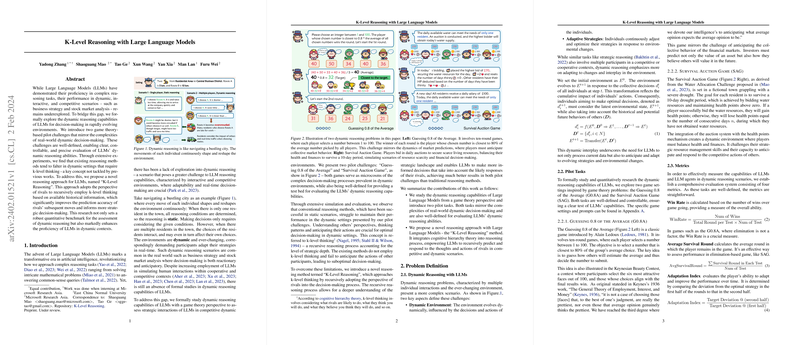Introduction
The examination of LLMs in static problem-solving has made considerable advances in recent years, with LLMs showing remarkable competencies across various complex tasks. However, their application in dynamic, interactive, and potentially competitive environments, such as those found in strategic business decisions or stock market analysis, has been less investigated. This gap is where the paper on "K-Level Reasoning with LLMs" finds its niche.
Problem Definition
Dynamic reasoning challenges arise in scenarios where not only the environment is continually evolving, but participants must also adaptively adjust their strategies in response to the results of others' actions. The paper introduces two game theory-based tasks echoing real-world strategic decision-making. One is the "Guessing 0.8 of the Average" (G0.8A) game, reflecting the essence of market prediction, while the other is the "Survival Auction Game" (SAG), echoing economic decisions under resource scarcity. These tasks, designed to mimic dynamic settings, serve as well-set platforms for evaluating the LLMs' dynamic reasoning capabilities.
K-Level Reasoning Approach
Addressing the limitations of conventional reasoning methods, the authors present "K-Level Reasoning," an innovative reasoning method for LLMs. This strategy involves a recursive reasoning process where a model adopts the perspective of a rival, contemplating how the rival would act based on available historical data. By considering the thought processes of opponents, the predictive accuracy of rivals' subsequent moves can be enhanced, therefore improving strategic decision-making. Extensive experimentation suggests that this approach offers LLMs a significant competitive edge.
Experimental Insights
The empirical findings in this work reveal intriguing behaviors:
- When faced with existing reasoning approaches, 'K-Level Reasoning' unsurprisingly outperforms, especially under dynamic settings exemplified in the G0.8A game.
- A deeper level of thought process, 'K-Level Reasoning,' yields a stronger strategic performance when compared to rivals utilizing lesser levels of cognitive depth. Interestingly, the paper shows that having a reasoning depth that is too advanced compared to opponents might yield diminishing returns—indicating a delicate balance to be maintained in the depth of strategic thought.
- The capabilities of reasoning methods significantly influence outcomes in dynamic settings. The shift from static to dynamic problems demands more elaborate reasoning processes, underlining the fact that simply extending practices used for one to the other may not suffice.
Conclusion
The research presented here underscores a considerable leap forward in the domain of dynamic reasoning with LLMs. By comparing 'K-Level Reasoning' to contemporary methods, it sets a robust quantitative benchmark for future studies. Perhaps more importantly, the authors have illuminated a path to enhancing the strategic decision-making efficacy of LLMs in environments that mimic the dynamic and combative realms we navigate in the real world.
